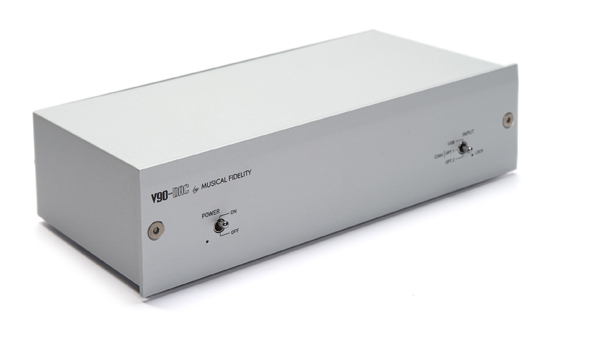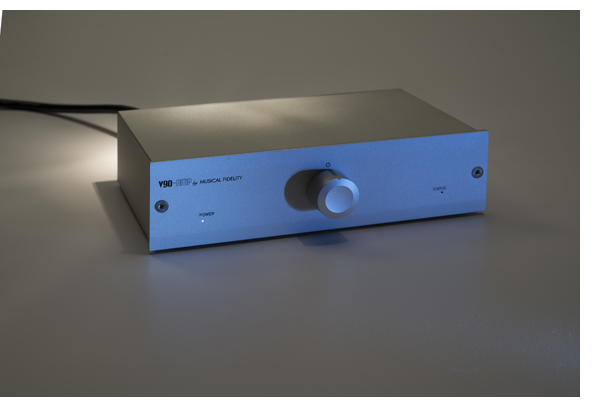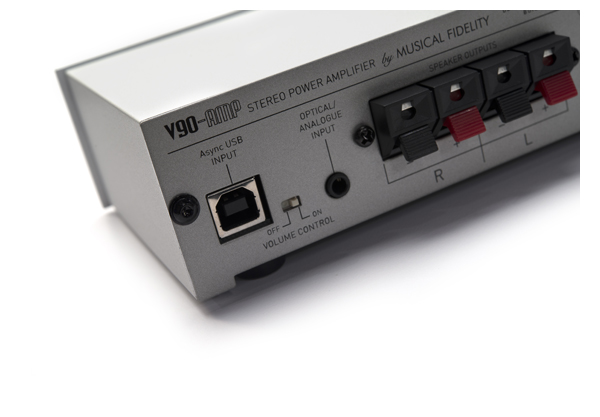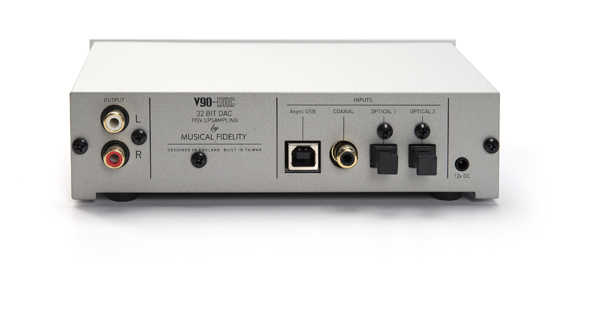Musical Fidelity V90-AMP and V90-DAC
 When it comes to achieving big sound, small components can usually only get you so far. But in a world where smartphones have become entrenched in our daily lives, big things are expected nonetheless. For many non-audiophiles, something that takes up one square foot is better than something that takes up 20 (not including cables). With that in mind, the new V90 series of mini-components from Musical Fidelity offers the opportunity to enjoy music in a limited amount of space while achieving quality commensurate with that of a primary audio system.
When it comes to achieving big sound, small components can usually only get you so far. But in a world where smartphones have become entrenched in our daily lives, big things are expected nonetheless. For many non-audiophiles, something that takes up one square foot is better than something that takes up 20 (not including cables). With that in mind, the new V90 series of mini-components from Musical Fidelity offers the opportunity to enjoy music in a limited amount of space while achieving quality commensurate with that of a primary audio system.
When assigned the new V90-AMP and V90-DAC from Musical Fidelity, I immediately grabbed the keys to my truck, assuming they were going to come in big packages. Instead, I was handed two white cardboard boxes no bigger than high school textbooks. In addition to the amp and DAC models ($300 each), V90 lineup includes the similarly sized V90-LPS phonostage, V90-HPA headphone amp, and V90-BLU Bluetooth receiver. (We will be featuring the phonostage in the next issue.)
The V90 products, which are assembled in Taiwan, feature custom casework with rounded corners and brushed aluminum faceplates. Their heft is noticeably more substantial than that of similar products from companies such as Lepai. And even when paired with full-size power cords, interconnects, and speaker wires, the V90 products won’t tip over backwards when plugged in.
V90-AMP
Opening the box for the V90-AMP, I’m immediately struck by the sight of an actual power cord instead of a power adapter. The Musical Fidelity design team has somehow managed to squeeze an actual power supply into a case no bigger than a paperback novel that also contains an integrated amplifier. This is huge with us at TONE, as wall warts are akin to a deep-space satellite dishes when it comes to electrical interference. (And our publisher also has a tendency to lose them.)
The silver-colored faceplate of the V90-AMP is reminiscent of full-size Musical Fidelity integrated amplifiers but with just two LED lights, for power and status, on either side of the click-step volume knob. The one omission is the power button, but as the V90-AMP’s Tripath chips use so little energy at idle, it can remain on all the time without ruining your carbon footprint.
The back panel is a model of efficiency; from left to right it features an asynchronous USB input, an on/off volume control switch, a combo optical/mini headphone input (a mini-to-RCA converter is included), right/left speaker cable ports, and the three-way power cord socket. Chances are, the V90-AMP is going to be used on a bookshelf or similar surface with 16-gauge speaker wire or thinner, so its spring-loaded speaker connections make perfect sense.
The Tripath chipset puts out 20 watts per channel at 8 ohms, with speakers having a nominal 6-ohm load being recommended. I spent the first half of the review period listening to the amp via the Harbeth Compact 7ES-3 speakers. Granted, this isn’t a realistic pairing due to their 85db sensitivity rating, but they give me solid insight into the capabilities of these two V90 products. The latter half of my listening is done through Totem Acoustic Rainmakers. Prior to engaging the DAC, the V90-AMP performs best through its analog headphone input, playing lossless files from either my MacBook using iTunes with Pure Music or my iPod Classic. In my experience, the amp’s USB input struggles with higher distortion, no matter what cable I use, though other listeners should test to see which inputs achieve the best experience, as results can vary.
Taking a listen to Blind Pilot’s “We Are The Tide,” I find that the Musical Fidelity signature of palpable bass exists with this amp, though at 20 wpc it offers just a taste rather than being truly impactful. Typical of Tripath-chip output, the initial punch is fast and tight. With the volume cranked, the V90-AMP stays solid and clean until the mid-90-dB range, when the soundstage collapses, but getting to that level is pretty impressive for a $300 mini-amplifier.
When delivering something with more of a rock vibe, the V90-AMP maintains the distinct, edgy electric guitar in Sahara Smith’s “The Real Thing.” In a home office, the V90-AMP has no problem sending enough energy to move air. It will never let you forget the impact that its mighty brother, the M6 integrated, can create, but it does offer a high level of contentment with appropriately sensitive speakers.
V90-DAC
As nifty as the V90-AMP is on its own, adding the matching V90-DAC takes the listening experience to a new level. Even the crunchiest recordings sound a magnitude or two better with the V90-DAC, which is able to upsample to a resolution of 32 bits/192 kHz. A Linn HD download of the Eagles’ “Desperado,” performed by singer Susan Wong, exudes a level of emotional ache I’ve never felt before via a budget DAC. A live recording of Amos Lee’s “Shout Out Loud” at just 16 bits/44 kHz recreates the intimacy of the small recording space.
The front panel of the V90-DAC, with its two small toggle switches, is a reminder of the 1980’s classic Apt Holman preamplifier. The left switch is for power and the right one offers the input choices of USB, coax/optical 1, and optical 2. The rear panel is divided between the RCA output jacks, the asynchronous USB, coax, optical 1, optical 2, and DC output. Unlike the matching amp, the V90-DAC uses a wall wart.
At the center of the V90-DAC’s design is the Burr-Brown 1795 chipset. The component immediately recognizes the bit-level differences between various files and adjusts without delay. Musical Fidelity claims that the V90-DAC’s jitter rate is just 15 pulses per second, with a distortion rate of 0.0003 percent. Money is spent where it matters with this product. Listening to live recordings reveals how well the V90-DAC resolves such sharp sounds as the tambourine in the Feeling’s “Sewn” that there are no fuzzy remnants to distort where the hand impact takes place.
The pleading, emotional vocals of Bruce Cockburn’s anti-war anthem “If I Had a Rocket Launcher” resonate with the V90-DAC in such a way that playing the laptop directly into the V90-AMP just can’t duplicate. Near the end of the live recording, the DAC picks up Cockburn’s deep but subtle breath, which the amp misses on its own, justifying spending the extra cash for the outboard DAC if you can make the stretch.
Sultry soprano Kathleen Edwards’ “Change the Sheets” sounds surprisingly smooth for this price point. In comparison to my reference $1,300 Simaudio 300D, the V90-DAC doesn’t have such lush detail, but for 25 percent of the cost, the V90-DAC justifies its $300 price tag just fine, thank you. The V90-DAC does what it does well, instead of reaching beyond its capabilities and weakening the overall presentation.
For those of you demanding a speedy transient attack, listening to Mumford and Sons’ “Holland Road” provides ample proof that the V90-DAC can handle quick sonic movements without a hiccup. The reproduced banjo sounds rich and resolved. Steve Martin’s impressive banjo fingering in “The Crow” confirms how well this unit handles quick transient attack.
Switching gears to complex symphonic music, I find that the Linn HD recording of the Scottish Chamber Orchestra’s rendition of Mozart’s “Requiem in D Minor” presents a few challenges to budget DACs: a beautiful high soprano and violins, followed by the intense impact of the full orchestra, which can easily become harsh and clouded, due to the timbrel complexity. The V90-DAC passes with flying colors, keeping both voices and instruments well sorted.
Final Score
Finding musical satisfaction away from one’s main system is a hit-and-miss proposition. The combination of Musical Fidelity’s V90-AMP and V90-DAC makes that time more pleasant. The V90-AMP, with its modest 20 wpc when paired with reasonably efficient speakers, creates an emotional connection to the music. It also offers a significant helping of the Musical Fidelity sound that is found in the company’s larger amplifiers: solid, well-controlled bass performance, and a natural tonality across the frequency spectrum without ever sounding harsh.
Fleshing out details otherwise missed is what any worthy budget DAC does best, and the V90-DAC performs this admirably. With this DAC, Musical Fidelity chose to focus on musical fundamentals, thus avoiding the budget trap of doing one thing great at the expense of others, and creating an excellent balance. Upper frequencies are particularly well resolved, even with the most difficult musical presentations. The V90-DAC’s performance makes it a piece of gear worthy of serious consideration, regardless of budget. Don’t let the diminutive size fool you!
Overall, these components make for an excellent, practical, and small-footprint solution for the home office, or for those with serious space constraints. — Mark Marcantonio





